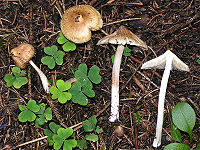
Photo from wikipedia
Five new Cortinarius species, C. neobalaustinus, C. pseudocamphoratus, C. subnymphatus, C. wuliangshanensis and C. yanjiensis spp. nov., are proposed based on a combination of morphological and molecular evidence. Cortinarius neobalaustinus… Click to show full abstract
Five new Cortinarius species, C. neobalaustinus, C. pseudocamphoratus, C. subnymphatus, C. wuliangshanensis and C. yanjiensis spp. nov., are proposed based on a combination of morphological and molecular evidence. Cortinarius neobalaustinus is characterized by a very weakly hygrophanous and yellowish-brown to brown pileus and small and weakly verrucose basidiospores. Cortinarius pseudocamphoratus can be characterized by a viscid pileus, a strongly unpleasant smell, amygdaloid to somewhat ellipsoid basidiospores and lageniform to subfusiform cheilocystidia. Cortinarius subnymphatus is identified by a strongly hygrophanous pileus that is reddish-brown with a black-brown umbo, a yellowish universal veil and ellipsoid to subamygdaloid basidiospores. Cortinarius wuliangshanensis is characterized by a moderately to strongly hygrophanous, translucently striated and yellowish to reddish-brown pileus and rather weakly and moderately verrucose basidiospores. Cortinarius yanjiensis is distinguished by a weakly to moderately hygrophanous and yellowish to brown pileus and moderately to rather strongly verrucose basidiospores. The phylogenetic analyses were performed with maximum likelihood and Bayesian inference methods based on the data set of nuc rDNA ITS1-5.8S-ITS2 (ITS), D1–D2 domains of nuc 28S rDNA (28S) and RNA polymerase II second largest subunit (rpb2), and the results show that C. neobalaustinus, C. wulianghsanensis and C. yanjiensis cluster in sect. Illumini, C. pseudocamporatus belongs to sect. Camphorati and C. subnymphatus belongs to sect. Laeti. In addition, a study of basidiospores under field emission scanning electron microscopy (FESEM) was conducted. An identification key for the five new species and related species from China is also provided.
Journal Title: Journal of Fungi
Year Published: 2022
Link to full text (if available)
Share on Social Media: Sign Up to like & get
recommendations!